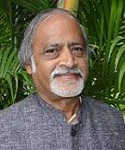| Biography | |
|---|---|
 Dr. S. Raghavan National Institute of Technology, India |
|
| Title: Microwave Integrated Circuit Components up to THz Design Made Easy | |
| Abstract: “It was in the late 1940s and early 1950s, when the microwave technology was beginning to emerge from the cocoon of war time secrecy that its applications started encompassing the non-military fields as well Since then, the entire field of microwaves has undergone tremendous revolution both in terms of techniques and technologies” _Prof.Bharathi Bhat (International pioneer in Microwave Integrated Circuits_M.I.C.s). The 1950s saw the entry of a new era of microwave semiconductor technology. The availability of small size semiconductor devices made it necessary to look for transmission media compatible with these devices. The answer was given by “Planar transmission line”. Skin depth at higher frequencies also found an indispensable need in the usage of ‘Planar transmission lines’ which formed the backbones of Microwave Integrated Circuits. M.I.C.s played an unparalleled technology when Waveguides found lesser preference. The planar transmission lines include Stripline, Microstripline, Slot line, Coplanar waveguide (CPW), Coplanar Strip(CPS), Finline and the variants of each transmission line like “inverted’. ‘V-groove’, ‘suspended’ etc. Substrate Integrated Waveguide(S I W) acts as the bridge between waveguide and planar transmission lines. Frequency Selective Surfaces (F S S) too are the present hot field technology. It will be shown that designing of M.I.C. components (Stub branch line couplers Backward wave couplers, Hybrid ring, Equal and Unequal Power dividers and Combiners etc.) up to THz are simply EASY as long as the Microwave Theory is followed with thorough understanding. Transmission lines being distributed network, initially the lumped equivalent of the corresponding stubs are obtained. .Initially ‘S’ matrix is obtained from the effective chain parameters and every stub is expressed in terms of the admittance and then Impedance. While designing the M.I.C. components three dimensions length (l), Width (w) and height (h) are to be determined. Out of three ‘h’ is taken care of by the substrate manufacturers (default being 1/16 “). Length is mostly in terms of guide wavelength (λg) which takes care of any material (since €eff is used) and frequency .Guide wavelength does miracles in the function of M.I.C.component design. There are infinite lambdas from ‘0’ to “lambda”. Transmission line equation will make one know the application of each length of a transmission line. The width ‘w’ is based on the characteristic impedance or even mode and odd mode impedances. Suitable nomograms are then used. Well defined closed form expressions are there .Matlab or Python programming can be used for self-coding. The layout of the components can be got with 100 % dimensional accuracy. Once the components are designed, systems (E.g. Mixer, Antennae, all types of filters, transponders etc) can be generated. When needed, even mode and odd mode analysis are taken for the analysis. FINALLY LAYOUT DESIGN IS OBTAINED WHICH CAN DIRECTLY BE TRANSFERRED FOR FABRICATION PROCESS. | |
| Biography: Dr. S. Raghavan Professor in Electronics and Communication Engineering Department, National Institute of Technology (N.I.T.), Trichy has 35 years of teaching and research experience. His interest includes Microwave Integrated Circuits, RF MEMS, BioMEMS, Metamaterial and Microwave Engineering. A proud research scholar of Prof. Bharathi Bhat and Prof. S K Koul, CARE, IIT Delhi, has established state of the art Microwave Integrated Circuit and Microwave Laboratory in N.I.T., Trichy with the help of Govt. of India funding. Won Best Teacher award twice and conferred with Honorary Fellowship of Ancient Sciences and Archaeological Society of India, His first Research Scholar obtained a Gold medal for the Best Thesis of the year. Short time visiting Fellow in California State University, North Ridge, USA. Awarded to conduct Tutorial in APEMC 2010, Beijing, China. Organizing Chair of ‘Indian Antenna Week 2014’, Chandigarh. Invited to be a session chair in PIERS 2013 symposium Taipei, Taiwan. Has to his credit 123 research papers in national and International Journals, 94 in IEEE Explore, 132 International conferences, 28 National conferences. Also, filed 3 patents. Guided 16 PhD scholars. Senior Member/Fellow in more than 20 international and national Professional Societies including IEEE, BES, IEI, IETE, CSI, TSI, ISTE, ISSS, NPC ISOI, ILA, IELTS and ASI. Organized various workshops of national importance. Has contributed lot in the development of state of the art Library (instrumental in the plan of the new Multistoried Library building as the then Library Coordinator) and Hospital (changed a clinical Dispensary into a 24 Hour hospital as the then Chairman of the Hospital Modernization committee) in NIT-T. He is an Executive Member of TSI and also in the Tamil Nadu Chapter of TSI. Also, the founding faculty advisor of IEEE MTT and APS student branch Chapters NIT Trichy. S. Raghavan is the author of Microwave Integrated Circuit Components Design through MATLAB. He Was the President of R.E.C., Trichy Faculty association for 2 years. Made an impact in MICROWAVE ENGINEERING EDUCATION among the student community at large. | |
